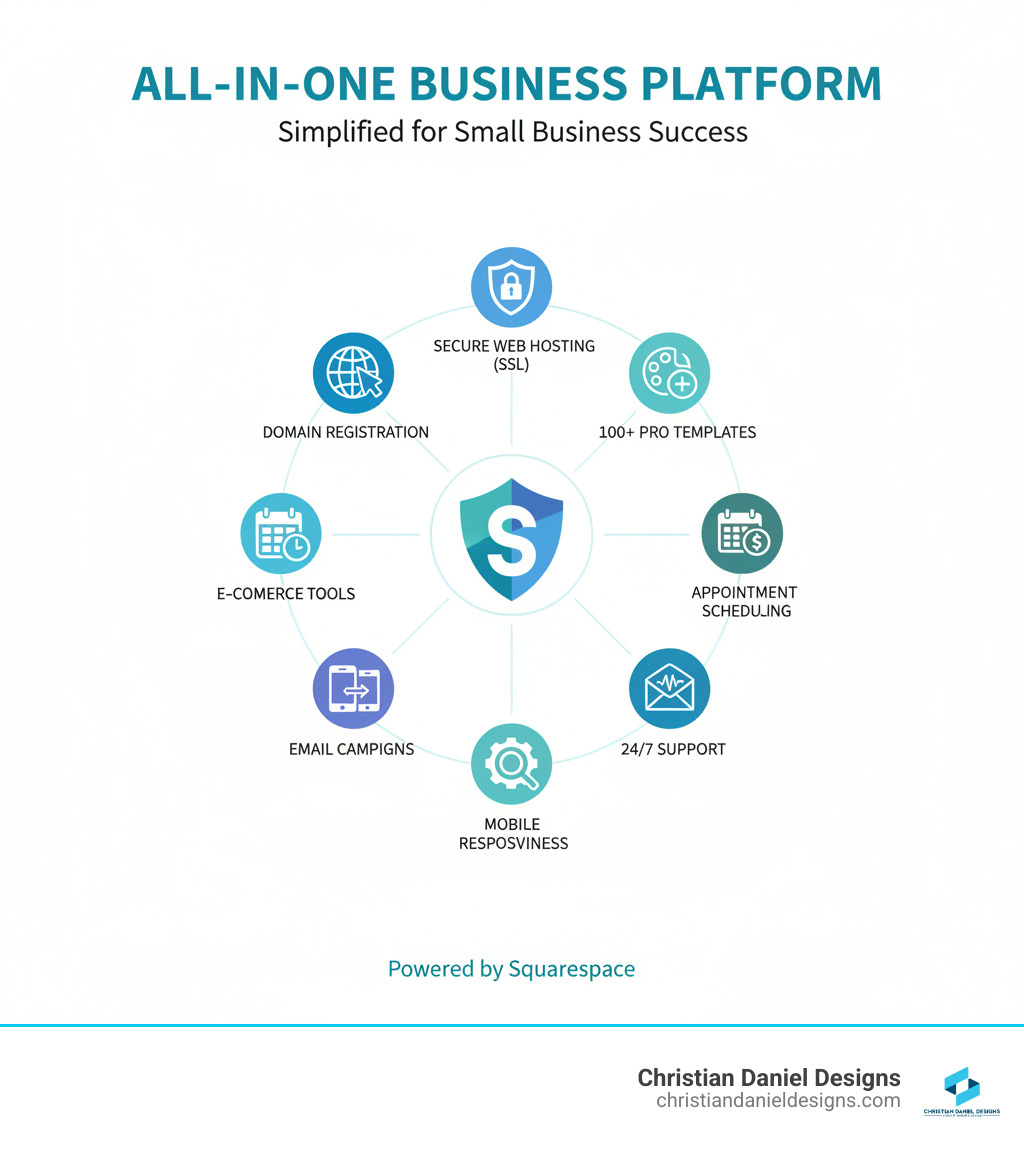Squarespace for small business: Ultimate 2025 Review
Why Small Businesses Are Choosing Squarespace for Small Business Websites
Squarespace for small business is an all-in-one platform for building and managing your online presence without code. Here’s the quick rundown:
Quick Answer: Is Squarespace Good for Small Business?
- Best For: Service businesses, creatives (photographers, artists), restaurants, consultants, and small online shops.
- Key Strengths: Beautiful templates, drag-and-drop editor, built-in hosting and security, 24/7 support, mobile-responsive design.
- Pricing: Plans start at $23/month (Business) to $27/month (Basic Commerce) when billed annually.
- Limitations: Not ideal for large e-commerce stores (10,000+ products), multilingual sites, or businesses needing extensive customization.
- Bottom Line: An excellent choice if you value ease of use, professional design, and low maintenance over maximum flexibility.
Running a small business is demanding. Your website should lighten the load, not add to it. That’s the promise of Squarespace: a professional site without the technical headaches. It bundles hosting, templates, security, e-commerce, and support into one package.
But is it right for your business? As the founder of Christian Daniel Designs, I’ve spent over 20 years building websites for hospitality and creative businesses on platforms like WordPress, Shopify, and Squarespace. I’ve seen what works for entrepreneurs who need results without an IT department.
This guide offers an honest review of Squarespace for small business, covering its strengths, weaknesses, and ideal users. By the end, you’ll know if it’s the right fit for your goals. I’ve built many high-performing sites on Squarespace because it strikes the perfect balance of beauty and function for most of my clients.

Squarespace for small business helpful reading:
What is Squarespace and Who Is It For?
Squarespace for small business is an all-in-one website builder, or Content Management System (CMS), that bundles everything you need to get online: hosting, domain registration, templates, security, e-commerce, and support.
Think of it like a high-end meal kit service for your website. Instead of sourcing all the technical ingredients yourself, everything arrives in one package with clear instructions, letting you focus on the creative part.
With over 3 million subscribers, Squarespace is a go-to for those who need a professional site but don’t want to become web developers. The platform handles all the backend maintenance, security updates, and SSL certificates so you can focus on running your business.
Why I Believe Squarespace Shines for Entrepreneurs
After 20 years of building websites, I keep returning to Squarespace for small business because it removes the technical barriers that slow entrepreneurs down. The drag-and-drop editor is genuinely intuitive; you click, move, and see changes in real-time. No code, no broken plugins after an update—just a clean, visual interface.
I’ve seen clients who called themselves “hopeless with technology” learn to update their own sites in an afternoon. This independence is priceless for a busy business owner. Squarespace allows you to create a professionally designed site and manage it yourself, freeing you from being a part-time IT department.
If you’re curious about how I help businesses make the most of this platform, you can learn more about my Square Space Website Design services.
Is Squarespace Right for Your Specific Business?
While not for everyone, Squarespace is the perfect choice for certain businesses. I’ve seen it work beautifully for:
- Photographers and Artists: The clean, visual templates make portfolios the star.
- Consultants and Coaches: Professional designs build trust and make it easy to book appointments.
- Restaurants and Cafes: It’s simple to display menus and integrate reservation systems like Tock (which Squarespace acquired).
- Bloggers: The writing and publishing tools are straightforward and enjoyable.
- Small Online Shops: It offers neat e-commerce features for boutique items or curated collections (up to 10,000 products).
- Service-Based Businesses (Salons, Studios, etc.): The built-in Acuity Scheduling feature is a game-changer for booking clients directly on your site.
The common thread is businesses that value aesthetics and ease of management. If you want a modern, professional website that works flawlessly on all devices and doesn’t require constant technical maintenance, Squarespace was designed for you.
The Pros and Cons of Using Squarespace for Small Business
Choosing a website platform is a major decision. After building dozens of sites on Squarespace, I have a clear view of where it excels and where it falls short for small businesses.

The Advantages: 7 Reasons I Recommend Squarespace
- All-in-One Solution: Hosting, domain, security, and support are bundled into one subscription. This saves money and mental energy, eliminating the need to juggle multiple vendors.
- Beautiful, Award-Winning Templates: Squarespace is known for its visually stunning templates built with smart user experience in mind. You can achieve an agency-level look right from the start.
- Low Maintenance: The platform handles all technical backend work, including updates and security patches. This “set it and forget it” approach lets you focus on your business, not IT.
- Excellent Security: Every site includes a free SSL certificate, and the closed system architecture has fewer vulnerabilities than platforms reliant on third-party plugins.
- 24/7 Customer Support: Access to help via email or live chat around the clock is invaluable, especially when working on tight deadlines. Their extensive Help Center is also a great resource.
- Solid Built-in Features: Squarespace provides a robust toolkit, including e-commerce, Acuity Scheduling for appointments, email marketing, and analytics, without needing separate services.
- Mobile-Responsive by Default: Every site automatically adjusts to look fantastic on phones, tablets, and desktops—an essential feature for engaging today’s customers.
If you’re curious to experience these benefits yourself, you can start your free Squarespace trial and explore for 14 days without any commitment.
The Disadvantages: 5 Cases Where You Might Look Elsewhere
- Large-Scale E-commerce: While great for most small businesses (up to 10,000 products), Shopify is superior for large-scale retail with complex inventory and shipping needs.
- Limited Multilingual Capabilities: Creating a truly multilingual site requires manually duplicating pages, which is tedious. Other platforms offer more neat solutions for international businesses.
- Smaller Plugin Ecosystem: Unlike WordPress’s vast plugin library, Squarespace has a smaller, curated collection of Extensions. This improves security but can feel restrictive if you need highly specialized functions.
- Transaction Fees on the Business Plan: Squarespace charges a 3% fee on sales made on its Business plan. You must upgrade to a Commerce plan to eliminate this fee, increasing your monthly cost.
- Restrictive for Complex Custom Functionality: The platform’s simplicity comes at the cost of some flexibility. If your business requires pixel-perfect custom designs or deep technical integrations, a platform like WordPress or Webflow might be a better fit.
A Deep Dive into Squarespace’s Core Features
Let me walk you through the specific features that make Squarespace for small business such a powerful tool for entrepreneurs.
Building Your Store: E-commerce and Online Sales
Squarespace offers a surprisingly robust suite of e-commerce tools. You can sell:
- Physical Products: Manage inventory, create detailed product pages, and track stock for up to 10,000 items.
- Digital Products: Securely sell e-books, online courses, music, or digital art with seamless downloads.
- Services: Allow clients to book and pay for your services in one smooth transaction.
The platform integrates with Stripe and PayPal for flexible payments. For in-person sales, the Point of Sale (POS) system syncs with Square readers, keeping your online and physical inventory aligned.
For a complete guide, check out my article on setting up a Squarespace Ecommerce Website.
Key SEO & Marketing Features of Squarespace for Small Business
A beautiful website is useless if no one can find it. Squarespace provides solid foundational tools for search engine optimization:
- Built-in SEO Tools: Easily customize page titles, meta descriptions, and create clean, keyword-friendly URLs.
- Automatic Sitemaps: Squarespace generates and submits an XML sitemap to help Google and Bing index your site.
- Website Analytics: The dashboard provides valuable insights on traffic sources, popular pages, and visitor behavior.
- Email Campaigns: Build mailing lists and send on-brand newsletters directly from the platform using the Email Campaigns feature.
- Integrations: Connect social media profiles and manage your Google My Business listing directly from your dashboard.
Streamlining Your Services: Scheduling and Memberships
For service businesses, the seamless integration with Acuity Scheduling is a game-changer. Clients can book appointments, classes, or events directly on your site 24/7. The system syncs with your calendar, processes payments, and sends automatic reminders, saving you hours of administrative work.
The Member Areas feature lets you monetize your expertise by creating gated content, online courses, or private communities. It’s a great way to build recurring revenue streams, though it has some limitations for more complex membership models.
Designing Your Brand: Customization and Flexibility
Squarespace’s design capabilities are a major strength, especially with the new Fluid Engine editor.

This drag-and-drop editor gives you precise control over element placement, allowing for truly custom layouts without code. You can establish a cohesive brand identity with extensive color palettes and font options (including Google and Adobe Fonts). For deeper customization, the platform supports custom CSS and code injection, which I often use to fine-tune designs and add unique elements for my clients.
To learn more, see my Squarespace Designs Ultimate Guide.
Squarespace vs. The Competition: A Head-to-Head Comparison
When choosing a platform, the conversation often comes down to Squarespace, WordPress, and Shopify. As someone who has worked with all three for over two decades, I’ve moved my company, Christian Daniel Designs, to be “ALL-IN” on Squarespace for client builds. Here’s a breakdown of how they compare.
| Feature | Squarespace | WordPress | Shopify |
|---|---|---|---|
| Ease of Use | Excellent (drag-and-drop, all-in-one) | Moderate to High (requires more technical skill, plugins) | Good (focused on e-commerce, intuitive backend) |
| Cost | Predictable (all-inclusive subscription) | Variable (hosting, themes, plugins, dev) | Predictable (subscription, transaction fees) |
| SEO | Good (built-in tools, clean code) | Excellent (highly customizable with plugins) | Good (built-in e-commerce SEO) |
| E-commerce | Good (up to 10k products, integrated) | Variable (requires WooCommerce plugin) | Excellent (built for large-scale e-commerce) |
| Maintenance | Low (managed by Squarespace) | High (updates, security, backups are DIY) | Low (managed by Shopify) |
| Flexibility | Moderate (template-based, some custom code) | Excellent (open-source, unlimited plugins) | Moderate (e-commerce focused, app store) |
| Best For | Creatives, service providers, content sites | Blogs, complex sites, custom functionality | Dedicated online stores, large product catalogs |
Squarespace vs. WordPress
This is the classic showdown. Squarespace dominates in ease of use and low maintenance. Its visual editor is intuitive, and Squarespace handles all security and updates for you. WordPress, being open-source, offers ultimate flexibility and a massive plugin ecosystem, but this comes at a cost. You are responsible for hosting, security, and updates, which can be time-consuming and technically demanding. I’ve seen too many hacked WordPress sites to recommend it to clients who aren’t prepared for that responsibility. While WordPress appears cheaper initially, costs for hosting, themes, and developer help add up, making Squarespace’s predictable subscription more appealing for many.
Squarespace vs. Shopify
This comparison is all about e-commerce. Shopify is built exclusively for online retail and is the superior choice for large, product-heavy stores with complex inventory and shipping needs. It has a massive app store for extending functionality. Squarespace excels for content-heavy sites that also sell products. Its templates are better for telling a brand story, showcasing a portfolio, or integrating a blog with a shop. If your business is primarily about your brand and services, with e-commerce as a component, Squarespace offers a more integrated and aesthetically pleasing solution. For smaller boutiques or creators selling merchandise, Squarespace’s e-commerce tools are more than sufficient.
Squarespace Pricing: Which Plan is Right for Your Business?
Squarespace’s pricing is straightforward, bundling everything into one subscription with a discount for annual billing. I’ll break down the plans to find the right fit for your business.

Breaking Down the Costs and Features
Here’s a quick look at the four main plans (prices reflect annual billing):
- Personal Plan (~$16/mo): Includes a custom domain, SSL security, and basic metrics. However, it lacks e-commerce, professional email, and advanced features. I rarely recommend this for a serious business.
- Business Plan (~$23/mo): The best starting point for most businesses. It includes everything in Personal, plus professional email from Google, advanced analytics, full customization with CSS/JS, and e-commerce capabilities (with a 3% transaction fee).
- Basic Commerce Plan (~$27/mo): This plan removes the 3% transaction fee. It also adds powerful e-commerce analytics and customer accounts, making it ideal once your online sales start to grow.
- Advanced Commerce Plan (~$49/mo): Built for scaling e-commerce. It adds abandoned cart recovery, advanced shipping and discount options, and the ability to sell subscriptions.
For the most current details, always View official pricing plans on Squarespace’s website.
My Recommendation on Choosing a Plan
After building countless Squarespace for small business sites, my advice is clear:
- Start with the Business Plan. It provides all the professional tools you need to get started, including e-commerce functionality. The 3% transaction fee is a reasonable cost when you’re just beginning to sell online.
- Upgrade to Basic Commerce when it makes financial sense. Once that 3% fee costs you more than the monthly price difference between plans, it’s time to upgrade. You’ll also gain valuable e-commerce features.
- Choose Advanced Commerce when you’re ready to optimize. Features like abandoned cart recovery can significantly boost revenue, making this plan a smart investment for established online stores.
Avoid the Personal Plan for your business. It’s a false economy. You’ll quickly outgrow its limitations and need to upgrade anyway. Your website is an investment, not just an expense to minimize.
Frequently Asked Questions about Squarespace
Over the years, I’ve heard the same questions from small business owners considering Squarespace for small business. Here are my honest answers to the top three.
How easy is it to use Squarespace if I have no tech skills?
It’s genuinely easy. Squarespace is designed for non-tech-savvy users. The drag-and-drop interface is intuitive, allowing you to see changes in real-time without touching code. I’ve taught many clients to manage their own sites—updating content, adding photos, and managing products—with just a brief training session.
Can my Squarespace website rank high on Google?
Absolutely. I’ve helped many clients achieve first-page Google rankings with Squarespace. The platform provides all the essential SEO tools (custom titles, clean URLs, sitemaps). However, ranking high depends more on your content strategy, keyword research, and the quality of your content than the platform itself. A well-optimized Squarespace site can easily outrank a poorly managed site on any other platform.
Can I move my existing website to Squarespace?
Yes, but it’s not a one-click process. You can import blog content from WordPress and transfer your domain. However, recreating pages and, most importantly, preserving your SEO value by setting up proper 301 redirects can be technical. For a large site, working with a professional is the best way to ensure a seamless transition without losing your search rankings.
Conclusion: My Final Verdict on Squarespace
After two decades of building websites, I can say with confidence: Squarespace for small business is an exceptional choice for most entrepreneurs, particularly in creative and service-based industries.
Your website should work for you, not create more work. Squarespace delivers on this by providing a beautiful, reliable, and secure platform that’s refreshingly simple to manage. It removes the technical headaches common with other platforms, so you can focus on running your business.
The design quality is outstanding, the all-in-one approach simplifies everything, and the built-in tools for e-commerce, scheduling, and marketing provide a solid foundation for growth.
Of course, it’s not perfect for everyone. If you’re running a massive e-commerce operation or need a complex multilingual site, platforms like Shopify or others might be a better fit. But for the vast majority of small businesses—photographers, consultants, restaurants, and boutiques—Squarespace hits the sweet spot between beauty, function, and ease of use.
Having a great platform is just the start. To turn your website into a strategic asset that drives growth, you often need an expert touch. As a Squarespace Website Designer in NYC, I specialize in changing Squarespace’s potential into custom, high-performing websites that deliver real results. If you’re ready to build a website that works as hard as you do, I’d love to help.